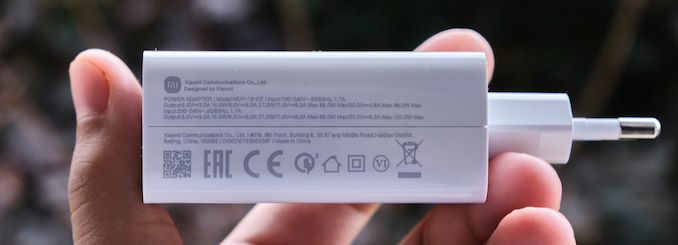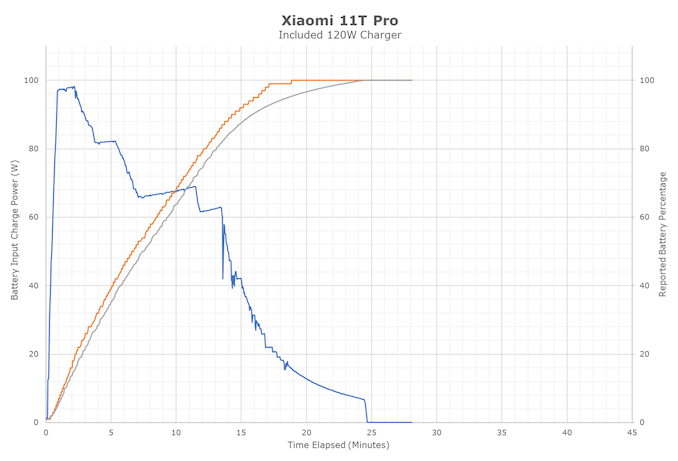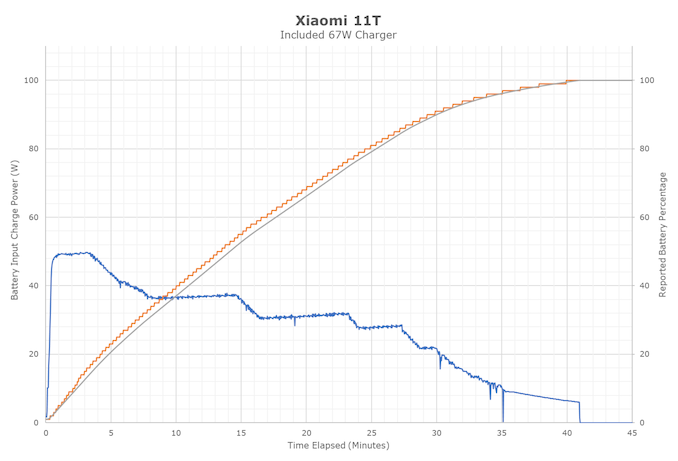The Xiaomi 11T & 11T Pro Review: Two Chips, With a Battery Focus
by Andrei Frumusanu on September 15, 2021 9:00 AM EST- Posted in
- Mobile
- Smartphones
- Xiaomi
- Xiaomi 11T
- Xiaomi 11T Pro
Fast Charging Note
Xiaomi is focusing the PR of the Mi 11T series on the fast-charging capabilities. Notably, the 11T Pro comes with a 120W fast charger:
It’s a USB-A connector on the power brick, and we can see that to achieve 120W the phone uses 20V and 6A transmission. The 6A is the rather special part as this requires a special thicker cable that’s included – otherwise any other generic cable will not allow to these kinds of power levels.
In terms of charging, we can see that the actual charge power into the phone reaches around 97W. The brick at the wall consumed up to 115W – keep that in mind when reading about fast-charging marketing claims, it’s mostly always the at the wall figure that’s being advertised.
The 97W figure only works up to around 20% charge, after which it goes down in steps to 80W to around 40%, 65-70W to 70%, and then gradually down to 6W. It’s notable that the phone doesn’t really do any trickle-charging at all. 0-100% happens in 25 minutes.
The regular 11T comes with a 67W charger, 20V at 3.25A. Peak power is around 49W in terms of charging the battery. It’s in general less aggressive, with 0-100% in 41 minutes.
Xiaomi made a few claims about the charging system a extract of the latest PR:
Xiaomi’s first smartphone to launch globally with the company's proprietary 120W Xiaomi HyperCharge technology. The industry-leading technology will enable a 100% charge in just 17 minutes*, giving creators more time to keep up with their creativity and minimize downtime by ensuring a full day use. This is achieved through innovative technologies such as dual charge pumps, dual-cell battery structure, MTW, Graphene application on Li-ion battery and Mi-FC technology. The safety of the battery is guaranteed by a TÜV Rheinland Safe Fast-Charge System Certification, 34 charging and battery safety features, real-time temperature monitoring and other measures
Notably, we had a few questions about the claims. First of all, the 17 minute claim is generally bogus – while yes, the phone does showcase a 100% status after around 17 minutes, which we reproduced, it actually doesn’t stop until around 25 minutes, when it reaches a true 100% figure. This is called fuzzy logic battery percentage reporting, and is generally used as a psychological incentive to not let your phone charge to 100% - almost every vendor out there does this, some to much worse discrepancies than showcased here.
We had sent Xiaomi a set of questions about 4 weeks ago, and gotten some answers only 2 days ago:
Q. Can we document the 34 safety features features?
A. Battery: High temperature charging/discharging protection, Low temperature charging/discharging protection, High current charging threshold management, Double overcharge protection, Overcurrent charging/discharging protection, Short circuit protection, Over-discharge protection, Battery safety encryption;
Circuit: Watch Dog, USB input over voltage protection, USB input under voltage protection, USB input overcurrent protection, Main charger Vout over voltage protection, Window under voltage protection, Window over voltage protection, Reverse current protection, Overheating shutdown protection, SMB VBAT protection, IBAT OCP protection, 2:1 input OVP protection, 2:1 output OVP protection, Battery monitoring system, Jeita charging protection, CC time out protection, PPS attach protection, PD authentication protection, Overheating NTC IC protection;
Charger: Short circuit protection, Overcurrent protection and overvoltage protection, Under voltage protection, Over-temperature protection, Cable encryption protection, Lightning protection, Electrostatic protection.
I questioned about the 34 charging features, and got an extensive list back as an answer. Generally, all these features are very much generic mechanisms that can be found in almost any smartphone, and are fundamental to any charge system, with only a few specific ones related to the serial battery charging being in any way special here.
Q. - What does up to 800 cycles mean? What are the criteria for this figure? Usually there's always some specification such as "retain up to 80% charge after 800 cycles".
- How were the charging cycles tested? What was the depth of charge of the battery (from which percentage start of charge to which percentage stop of charge) - are these partial of full charge cycles?
- How much more is the battery degraded compared to regular charging speeds? Does Xiaomi have any data to share in regards to battery health?
A. [...] The battery can obviously handle way more than just 800 cycles. You are absolutely right, the idea here is that it will maintain 80% of its capacity after 800 charging cycles, which is roughly two years before you'll notice any real difference. For most smartphones that number stands at only 500 cycles. The testing conditions are simple, we test the batteries under room temperature charging and discharging it thousands of times to make sure that the battery is able to retain most of its capacity.
In the initial PR a few weeks ago the 80% figure wasn’t mentioned, hence why I asked about the 800 cycles number.
In general, the issue we’ve been having with a lot of vendors is that we are having a lot of issue in getting anybody to actually specify the exact details of the test environment of these charge cycle tests and results.
In particular, I’m asking about the depth of charge of the test – a cycle can either be a full 0-100% charge, or it can also be 5 40-60% charges, in battery terminology, both of those count as a full cycle, however the 0-100% cycle will put significantly more stress and degrade the battery a lot more than the 5x 40-60% cycles.
Xiaomi here also isn’t very clear in their answer and didn’t address the question. Particularly, they talk about “most smartphones” only able to achieve 500 cycles, however, most smartphones don’t have 120W charging, so it can’t possibly be a valid comparison.
Xiaomi also notes that the battery is tested under “lab conditions” – this was also a topic of kerfuffle we’ve had with OPPO last year as the company kept producing questionable test results without any context of test methodology.
Usually, these battery stress tests are done via industrial battery charge/discharge capacity testers, meaning they are testing merely the battery cell, outside of the phone - a very important distinction compared to actual phone charge cycle stress testing.
Q Follow-up. - Can I get a clarification as whether this means that the batteries are being tested externally, outside of the phone, or if this means that the phone itself is being charged and discharged with the 120W system?.
I followed-up with the above question for clarification. This was also a stickling point with OPPO last year, as they would refuse to answer that the advertised charge cycles and capacity retention was actually tested with the advertised fast-charging system. I haven’t had a response from Xiaomi yet on the matter, however this was extremely close to the embargo time, I'll make sure to follow up if they do respond.
Q. For the TÜV certification - we've had similar claims from other OEMs, but the issue was that the certification doesn't have any public test methodology documented, nor are the exact results ever published. It is our understanding that this certification only essentially checks that the device doesn't result in any hazardous situation, but doesn't test things like battery health. Any more information is helpful."
A.Correct, the TÜV and other battery safety certifications are mainly focused on battery safety, and not on battery health.
However, at Xiaomi we use laboratory cycle verification, third-party laboratory tests, and ORT verification methods to ensure that the battery cycle life meets the highest standards.
Finally, I asked about clarification about the TÜV certifications. This was also a stress point in an interaction with OPPO last year, as they were trying to portray that the TÜV certification actually is testing battery degradation. Documents sent to me at the time were clear that they were completely unrelated to the fast-charge system.
Xiaomi deserves credit here to properly dismissing that notion and confirming that the TÜV certification is only related to safety – as in, they test that the charger or phone don’t blow up. Battery health and degradation is unrelated to the (non-public) test-procedures and certification.
Unfortunately, it’s been extremely hard to get a clear non-evasive answer from any vendors out there that promotes such extreme fast-charging systems. Xiaomi here also wasn’t able to produce any kind of convincing evidence that would argument that the 120W charging system doesn’t notably impact battery degradation.
We’re in the process of writing up a more dedicated and general fast-charging article that focuses on real data, and the actual latest science on fast charging. There is an incredible amount of misinformation, misconceptions, and outright falsehoods that are floating out there that we want to address.













41 Comments
View All Comments
arayoflight - Wednesday, September 15, 2021 - link
The battery life test of D1200 phone is rather surprising. The OnePlus Nord 2 which uses the same chipset does pretty well in GSMArena's battery test: https://fdn.gsmarena.com/imgroot/reviews/21/oneplu...yeeeeman - Wednesday, September 15, 2021 - link
Yep, I suspect this is a xiaomi thing, not something really bad with the soc, as I would expect mediatek engineer to be able to test power consumption of their soc before releasing it to the market.flipp0 - Thursday, September 16, 2021 - link
Yes, I had the Nord 2 and battery life was great. I think it is likley that anandtech got a faulty 11T unit or that 11T has some kind of software bug draining the battery. I am suprised that Andrei does not mention this a possible explanation for the results reported in this review.Spunjji - Monday, September 20, 2021 - link
Crappy software. Glad to see they fixed it, but that was pretty poor to be releasing a review unit in such a bad state.eastcoast_pete - Wednesday, September 15, 2021 - link
Thanks for the test, especially taking a close look at power management of the SoCs! I guess the overheating issue with the 888 indicates both the appetite of the X1 for power, and the need for good thermal design when used in a close, confined space like a Smartphone. Almost looks as if Xiaomi assumed that designs for older, lower powered SoCs would work just fine with the 888, and was in for a nasty surprise when it didn't.It's too bad that Xiaomi seems to then insist on "improving" these phones with their idea of enhancement by software, which clearly doesn't work. Those results for the Dimensity are also surprising, and not in a good way.
The temperatures measured remind me of an old phone with the SD 808 many years ago; probably the worst SoC QC I ever had the displeasure of owning.
shabby - Wednesday, September 15, 2021 - link
Interesting to see the price difference when the only difference is the soc, Qualcomm sure charges a premium.shabby - Wednesday, September 15, 2021 - link
But ouch that battery life, shirley some software updates might fix this?Spunjji - Monday, September 20, 2021 - link
And they did!PEJUman - Wednesday, September 15, 2021 - link
Curious if Xiaomi is using 'power' cells instead of 'energy' cells on their phones. Or if they are simply pushing energy cells with obscene C rates (at 4V * 4Ah, that's a mere 16 Wh of energy capacity), charging this at 100+ Watts to full is basically 6+ C charging rates.Either they have great battery tech, not sure who is their supplier for these... or the customer will just have to contend with rapid aging of their battery as they fast charge it everyday.
DanNeely - Wednesday, September 15, 2021 - link
Killing batteries early goes right with making battery replacement difficult as a means to drive more sales of new phones.